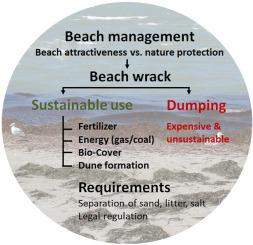当前位置:
X-MOL 学术
›
Ocean Coast Manage.
›
论文详情
Our official English website, www.x-mol.net, welcomes your
feedback! (Note: you will need to create a separate account there.)
Converting beach wrack into a resource as a challenge for the Baltic Sea (an overview)
Ocean & Coastal Management ( IF 4.8 ) Pub Date : 2021-02-01 , DOI: 10.1016/j.ocecoaman.2020.105413 B. Chubarenko , J. Woelfel , J. Hofmann , S. Aldag , J. Beldowski , J. Burlakovs , T. Garrels , J. Gorbunova , S. Guizani , A. Kupczyk , L. Kotwicki , D. Domnin , M. Gajewska , W. Hogland , K. Kołecka , J. Nielsen , H. Schubert
Ocean & Coastal Management ( IF 4.8 ) Pub Date : 2021-02-01 , DOI: 10.1016/j.ocecoaman.2020.105413 B. Chubarenko , J. Woelfel , J. Hofmann , S. Aldag , J. Beldowski , J. Burlakovs , T. Garrels , J. Gorbunova , S. Guizani , A. Kupczyk , L. Kotwicki , D. Domnin , M. Gajewska , W. Hogland , K. Kołecka , J. Nielsen , H. Schubert

|
Abstract The paper distinguishes beach wrack, the marine generated organic part of beach cast, as a separate management object and discusses research questions related to its management and economically viable use. Based on experiences from the Baltic Sea and existing practices from countries with different management systems clear distinction between the management of natural and anthropogenic components of cast material is seen as an essential prerequisite for developing sustainable product chains that allow beach wrack to be used as a resource of commercial value. Presenting and discussing examples from Denmark (Koge Municipality), Germany (Kuhlungsborn, Rugen and Poel Island), Poland (Gulf of Gdansk), Russia (Curonian and Vistula spits) and Sweden (Kalmar municipality and Oland), social, ecological, and economic consequences of beach wrack removal are analysed to improve the attractiveness of beaches for recreational purposes. It also includes potential contribution to Baltic Sea water restoration processes through the removal of the organic part of beach cast, where indeed more studies about the chemical (nutrients, metals) composition of beach wrack are required for reliable calculation of a depuration rate. For local economies within the Baltic Sea region, the organic part of beach cast (beach wrack and terrestrial debris) has reasonable economic prospects as a renewable natural resource, e.g. for soil improvement products, in fertilisers and bio-coal production, for landfill covers (contributing to climate change mitigation), biogas generation, and even for coastal protection by providing humus-like material for accelerated dune vegetation succession. For all these recycling options the development of cost-efficient technologies for collecting beach cast on sandy as well as stony beaches and also for separating the organic part from sand and anthropogenic litter (mainly plastic), is urgently required. Amendments of legal regulations, that better reflect the dualism of beach cast are also required. In essence, dualism results from the fact that beach wrack is a part of nature (or a natural resource) when it remains on a beach. However, beach wrack immediately becomes legally categorised as waste once humans collect it irrespective of its litter content. Another legal aspect being dealt with originates from the migration of the beach wrack between water and beach, whilst it is an object of ерleagl cleaning operations only at the beach it onto the beach, but not whilst in the water.
中文翻译:

将海滩残骸转化为资源作为波罗的海的一项挑战(概述)
摘要 本文将海滩残骸(海滩抛物的海洋产生的有机部分)区分为一个单独的管理对象,并讨论了与其管理和经济上可行的利用相关的研究问题。根据波罗的海的经验和不同管理系统国家的现有做法,明确区分铸造材料的自然成分和人为成分的管理被视为开发可持续产品链的必要先决条件,使海滩残骸可以用作资源具有商业价值。展示和讨论来自丹麦(Koge 市)、德国(Kuhlungsborn、Rugen 和 Poel 岛)、波兰(格但斯克湾)、俄罗斯(Curonian 和 Vistula 唾液)和瑞典(Kalmar 市和 Oland)、社会、生态、分析海滩残骸清除的经济后果,以提高海滩对休闲目的的吸引力。它还包括通过去除海滩铸件的有机部分对波罗的海海水恢复过程的潜在贡献,确实需要对海滩残骸的化学(营养物、金属)成分进行更多研究,以可靠计算净化率。对于波罗的海地区的当地经济,海滩垃圾的有机部分(海滩残骸和陆地垃圾)作为可再生自然资源具有合理的经济前景,例如用于土壤改良产品、肥料和生物煤生产、垃圾填埋场覆盖物(为减缓气候变化做出贡献)、沼气发电、甚至通过为加速沙丘植被演替提供类腐殖质材料来保护海岸。对于所有这些回收选择,迫切需要开发具有成本效益的技术来收集沙滩和石质海滩上的沙滩,以及从沙子和人为垃圾(主要是塑料)中分离有机部分。还需要修改法律法规,以更好地反映海滩演员的二元性。从本质上讲,二元论源于这样一个事实,即海滩残骸留在海滩上时是自然(或自然资源)的一部分。然而,一旦人类收集海滩残骸,无论其垃圾含量如何,海滩残骸都会立即在法律上归类为废物。正在处理的另一个法律方面源于海滩残骸在水和海滩之间的迁移,
更新日期:2021-02-01
中文翻译:

将海滩残骸转化为资源作为波罗的海的一项挑战(概述)
摘要 本文将海滩残骸(海滩抛物的海洋产生的有机部分)区分为一个单独的管理对象,并讨论了与其管理和经济上可行的利用相关的研究问题。根据波罗的海的经验和不同管理系统国家的现有做法,明确区分铸造材料的自然成分和人为成分的管理被视为开发可持续产品链的必要先决条件,使海滩残骸可以用作资源具有商业价值。展示和讨论来自丹麦(Koge 市)、德国(Kuhlungsborn、Rugen 和 Poel 岛)、波兰(格但斯克湾)、俄罗斯(Curonian 和 Vistula 唾液)和瑞典(Kalmar 市和 Oland)、社会、生态、分析海滩残骸清除的经济后果,以提高海滩对休闲目的的吸引力。它还包括通过去除海滩铸件的有机部分对波罗的海海水恢复过程的潜在贡献,确实需要对海滩残骸的化学(营养物、金属)成分进行更多研究,以可靠计算净化率。对于波罗的海地区的当地经济,海滩垃圾的有机部分(海滩残骸和陆地垃圾)作为可再生自然资源具有合理的经济前景,例如用于土壤改良产品、肥料和生物煤生产、垃圾填埋场覆盖物(为减缓气候变化做出贡献)、沼气发电、甚至通过为加速沙丘植被演替提供类腐殖质材料来保护海岸。对于所有这些回收选择,迫切需要开发具有成本效益的技术来收集沙滩和石质海滩上的沙滩,以及从沙子和人为垃圾(主要是塑料)中分离有机部分。还需要修改法律法规,以更好地反映海滩演员的二元性。从本质上讲,二元论源于这样一个事实,即海滩残骸留在海滩上时是自然(或自然资源)的一部分。然而,一旦人类收集海滩残骸,无论其垃圾含量如何,海滩残骸都会立即在法律上归类为废物。正在处理的另一个法律方面源于海滩残骸在水和海滩之间的迁移,











































 京公网安备 11010802027423号
京公网安备 11010802027423号